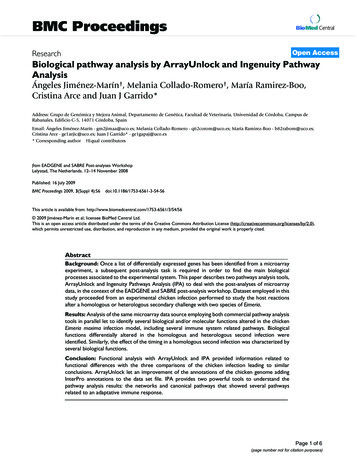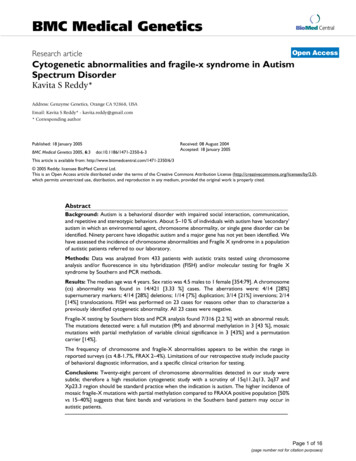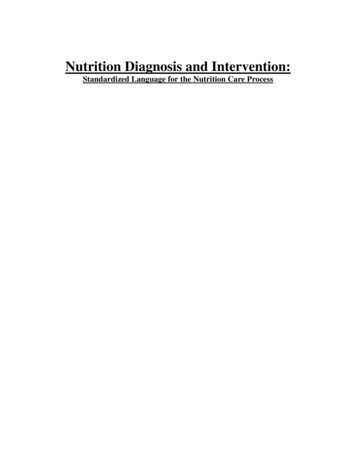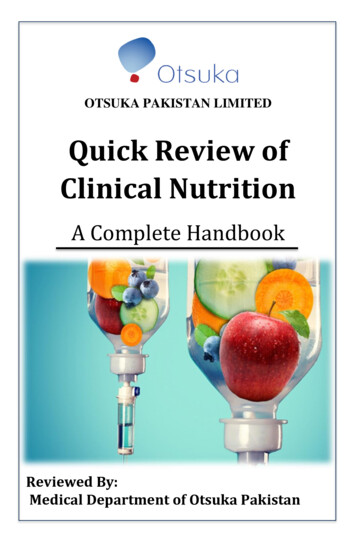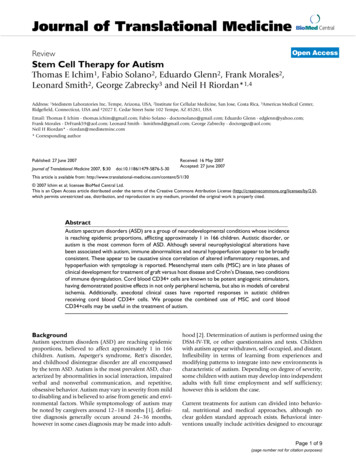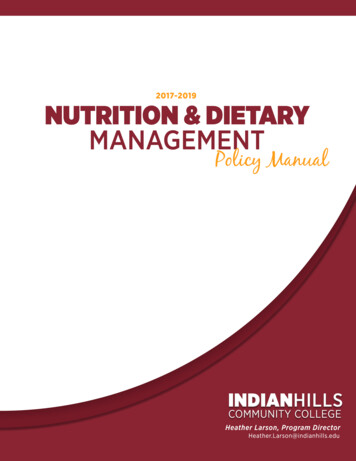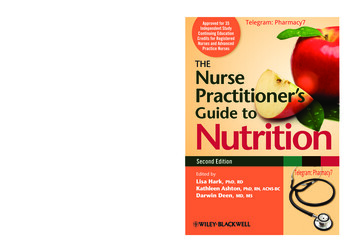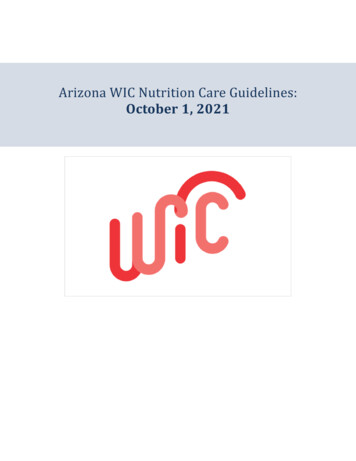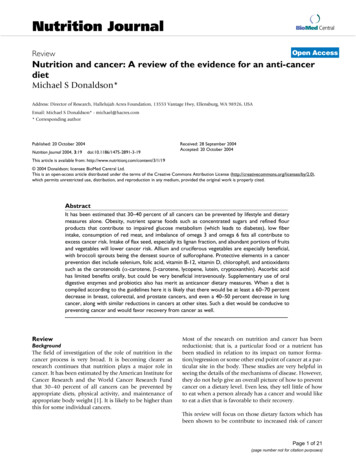
Transcription
Nutrition JournalBioMed CentralOpen AccessReviewNutrition and cancer: A review of the evidence for an anti-cancerdietMichael S Donaldson*Address: Director of Research, Hallelujah Acres Foundation, 13553 Vantage Hwy, Ellensburg, WA 98926, USAEmail: Michael S Donaldson* - michael@hacres.com* Corresponding authorPublished: 20 October 2004Nutrition Journal 2004, 3:19doi:10.1186/1475-2891-3-19Received: 28 September 2004Accepted: 20 October 2004This article is available from: http://www.nutritionj.com/content/3/1/19 2004 Donaldson; licensee BioMed Central Ltd.This is an open-access article distributed under the terms of the Creative Commons Attribution License (http://creativecommons.org/licenses/by/2.0),which permits unrestricted use, distribution, and reproduction in any medium, provided the original work is properly cited.AbstractIt has been estimated that 30–40 percent of all cancers can be prevented by lifestyle and dietarymeasures alone. Obesity, nutrient sparse foods such as concentrated sugars and refined flourproducts that contribute to impaired glucose metabolism (which leads to diabetes), low fiberintake, consumption of red meat, and imbalance of omega 3 and omega 6 fats all contribute toexcess cancer risk. Intake of flax seed, especially its lignan fraction, and abundant portions of fruitsand vegetables will lower cancer risk. Allium and cruciferous vegetables are especially beneficial,with broccoli sprouts being the densest source of sulforophane. Protective elements in a cancerprevention diet include selenium, folic acid, vitamin B-12, vitamin D, chlorophyll, and antioxidantssuch as the carotenoids (α-carotene, β-carotene, lycopene, lutein, cryptoxanthin). Ascorbic acidhas limited benefits orally, but could be very beneficial intravenously. Supplementary use of oraldigestive enzymes and probiotics also has merit as anticancer dietary measures. When a diet iscompiled according to the guidelines here it is likely that there would be at least a 60–70 percentdecrease in breast, colorectal, and prostate cancers, and even a 40–50 percent decrease in lungcancer, along with similar reductions in cancers at other sites. Such a diet would be conducive topreventing cancer and would favor recovery from cancer as well.ReviewBackgroundThe field of investigation of the role of nutrition in thecancer process is very broad. It is becoming clearer asresearch continues that nutrition plays a major role incancer. It has been estimated by the American Institute forCancer Research and the World Cancer Research Fundthat 30–40 percent of all cancers can be prevented byappropriate diets, physical activity, and maintenance ofappropriate body weight [1]. It is likely to be higher thanthis for some individual cancers.Most of the research on nutrition and cancer has beenreductionist; that is, a particular food or a nutrient hasbeen studied in relation to its impact on tumor formation/regression or some other end point of cancer at a particular site in the body. These studies are very helpful inseeing the details of the mechanisms of disease. However,they do not help give an overall picture of how to preventcancer on a dietary level. Even less, they tell little of howto eat when a person already has a cancer and would liketo eat a diet that is favorable to their recovery.This review will focus on those dietary factors which hasbeen shown to be contribute to increased risk of cancerPage 1 of 21(page number not for citation purposes)
Nutrition Journal 2004, 3:19http://www.nutritionj.com/content/3/1/19and then on those additional protective dietary factorswhich reduce cancer risk. Finally, some whole-diet studieswill be mentioned which give a more complete picture ofhow these individual factors work together to reduce cancer risk.nutrition) prior to age 40, there was a 23% lower incidence of breast cancer for nulliparous women and a 76%lower incidence for parous women [10]. So, too many calories is definitely counter-productive, and slightly lessthan normal is very advantageous.Over Consumption of Energy (Calories)Eating too much food is one of the main risk factors forcancer. This can be shown two ways: (1) by the additionalrisks of malignancies caused by obesity, and (2) by theprotective effect of eating less food.Glucose MetabolismRefined sugar is a high energy, low nutrient food – junkfood. "Unrefined" sugar (honey, evaporated cane juice,etc) is also very concentrated and is likely to contribute tothe same problems as refined sugar. Refined wheat flourproducts are lacking the wheat germ and bran, so theyhave 78 percent less fiber, an average of 74 percent less ofthe B vitamins and vitamin E, and 69 percent less of theminerals (USDA Food database, data not shown). Concentrated sugars and refined flour products make up alarge portion of the carbohydrate intake in the averageAmerican diet. One way to measure the impact of thesefoods on the body is through the glycemic index.Obesity has reached epidemic proportions in the UnitedStates. Sixty-four percent of the adult population is overweight or obese [2]. About 1 in 50 are now severely obese(BMI 40 kg/m2) [3]. Mokdad et al [4] found that poordiet and physical inactivity was the second leading causeof death (400,000 per year in the USA), and would likelyovertake tobacco as the leading cause of death.It was estimated in a recent study, from a prospective cancer prevention cohort, that overweight and obesityaccounted for 14 percent of all cancer deaths in men and20 percent of those in women [5]. Significant positiveassociations were found between obesity and higherdeath rates for the following cancers: esophagus, colonand rectum, liver, gallbladder, pancreas, kidney, stomach(in men), prostate, breast, uterus, cervix, and ovary [5].The authors estimated that over 90,000 cancer deaths peryear could be avoided if the adult population all maintained a normal weight (BMI 25.0) [5]. Clearly, obesityis a major risk factor for cancer.On the other side, careful menu planning brings about anapproach entitled CRON-Calorie Restriction with Optimal Nutrition. The basic idea is to eat a reduced amountof food (about 70–80 percent of the amount required tomaintain "normal" body weight) while still consuming allof the necessary amounts of vitamins, minerals, and othernecessary nutrients. The only restriction is the totalamount of energy (calories) that is consumed. Whilebeing difficult to practice, this approach has a lot of scientific merit for being able to extend average life spans ofmany species of animals including rats, mice, fish, andpossibly primates (currently being tested). Along with thislife span extension is a reduction in chronic diseases thatare common to mankind, reviewed in Hursting et al [6]. Arecent meta-analysis of 14 experimental studies foundthat energy restriction resulted in a 55% reduction inspontaneous tumors in laboratory mice [7]. Calorierestriction inhibited induced mammary tumors in mice[8] and suppressed implanted tumor growth and prolonged survival in energy restricted mice [9]. AmongSwedish women who had been hospitalized for anorexianervosa (definitely lower caloric intake, but not adequateThe glycemic index is an indication of the blood sugarresponse of the body to a standardized amount of carbohydrate in a food. The glycemic load takes into accountthe amount of food eaten. An international table of theglycemic index and glycemic load of a wide variety offoods has been published [11].Case-control studies and prospective population studieshave tested the hypothesis that there is an associationbetween a diet with a high glycemic load and cancer. Thecase control studies have found consistent increased riskof a high glycemic load with gastric [12], upper aero digestive tract [13], endometrial [14], ovarian [15], colon orcolorectal cancers [16,17]. The prospective studies' resultshave been mixed. Some studies showed increased risk ofcancer in the whole cohort with high glycemic load [1820]; some studies found only increased risk among subgroups such as sedentary, overweight subjects [21-24];other studies concluded that there was no increased riskfor any of their cohort [25-28]. Even though there were noassociations between glycemic load and colorectal, breast,or pancreatic cancer in the Nurses' Health Study there wasstill a strong link between diabetes and colorectal cancer[29].Perhaps the dietary glycemic load is not consistentlyrelated to glucose disposal and insulin metabolism due toindividual's different responses to the same glycemic load.Glycated hemoglobin (HbA1c) is a time-integrated measurement of glucose control, and indirectly, of insulin levels. Increased risk in colorectal cancer was seen in theEPIC-Norfolk study with increasing HbA1c; subjects withknown diabetes had a three-fold increased risk of colorectal cancer [30]. In a study of a cohort in Washingtoncounty, Maryland, increased risk of colorectal cancer wasPage 2 of 21(page number not for citation purposes)
Nutrition Journal 2004, 3:19seen in subjects with elevated HbA1c, BMI 30 kg/m2, orwho used medications to control diabetes [31]. However,glycated hemoglobin was not found to be associated withincreased risk of colorectal cancer in a small nested casecontrol study within the Nurses' Health Study [32]. Elevated fasting glucose, fasting insulin, 2 hour levels of glucose and insulin after an oral glucose challenge, and largerwaist circumference were associated with a higher risk ofcolorectal cancer [33]. In multiple studies diabetes hasbeen linked with increased risk of colorectal cancer [3437], endometrial cancer [38], and pancreatic cancer[35,39]. It is clear that severe dysregulation of glucosemetabolism is a risk factor for cancer. Foods which contribute to hyperinsulinemia, such as refined sugar, foodscontaining refined sugar, and refined flour productsshould be avoided and eliminated from a cancer protective diet.Low FiberUnrefined plant foods typically have an abundance offiber. Dairy products, eggs, and meat all have this in common – they contain no fiber. Refined grain products alsohave most of the dietary fiber removed from them. So, adiet high in animal products and refined grains (a typicaldiet in the USA) is low in fiber. In prospective health studies low fiber was not found to be a risk for breast cancer[25]. It is possible that fiber measurements are just a surrogate measure for unrefined plant food intake. Slattery etal [40] found an inverse correlation between vegetable,fruit and whole grain intake plant food intake and rectalcancer, while refined grains were associated withincreased risk of rectal cancer. A threshold of about 5 dailyservings of vegetables was needed to reduce cancer riskand the effect was stronger among older subjects [40].Many other nutrients are co-variants with fiber, includingfolic acid, which is covered in detail below.Red MeatRed meat has been implicated in colon and rectal cancer.A Medline search in February 2003 uncovered 26 reportsof human studies investigating the link between diet andcolon or colorectal cancer. Of the 26 reports, 21 of themreported a significant positive relationship between redmeat and colon or colorectal cancer [17,41-64]. A recentmeta-analysis also found red meat, and processed meat, tobe significantly associated with colorectal cancer [65].Meat, and the heterocyclic amines formed in cooking,have been correlated to breast cancer in a case-controlstudy in Uruguay as well [66].Omega 3:6 Ratio ImbalanceOmega 3 fats (alpha-linolenic acid, EPA, DHA) have beenshown in animal studies to be protect from cancer, whileomega 6 fats (linoleic acid, arachidonic acid) have beenfound to be cancer promoting fats. Now there have l studies that have tested this hypothesis in relationto breast cancer, summarized in Table 1. Except for thestudy by London et al [67], all of these studies found anassociation between a higher ratio of N-3 to N-6 fats andreduced risk of breast cancer. Long chain N-3 and N-6 fatshave a different effect on the breast tumor suppressorgenes BRCA1 and BRCA2. Treatment of breast cell cultureswith N-3 fats (EPA or DHA) results in increased expression of these genes while arachadonic acid had no effect[68]. Flax seed oil and DHA (from an algae source) bothcan be used to increase the intake of N-3 fat, with DHAbeing a more efficient, sure source.Flax seedFlax seed provides all of the nutrients from this smallbrown or golden hard-coated seed. It is an excellent sourceof dietary fiber, omega 3 fat (as alpha-linolenic acid), andlignans. The lignans in flax seed are metabolized in thedigestive tract to enterodiol and enterolactone, whichhave estrogenic activity. In fact, flax seed is a more potentsource of phytoestrogens than soy products, as flax seedintake caused a bigger change in the excretion of 2hydroxyestrone compared to soy protein [69].Ground flax seeds have been studied for its effect on cancer, including several excellent studies by Lilian Thompson's research group at the University of Toronto. In onestudy the flax seed, its lignan fraction, or the oil wereadded to the diet of mice who had previously beenadministered a chemical carcinogen to induce cancer. Allthree treatments reduced the established tumor load; thelignan fraction containing secoisolariciresinol diglycoside(SDG) and the flax seed also reduced metastasis [70]. Inanother study the flax lignan SDG was fed to mice starting1 week after treatment with the carcinogen dimethylbenzanthracene. The number of tumors per rat was reducedby 46% compared to the control in this study [71]. Flax orits lignan (SDG) were tested to see if they would preventmelanoma metastasis. The flax or lignan fraction were fedto mice two weeks before and after injection of melanomacells. The flax treatment (at 2.5, 5, or 10% of diet intake)resulted in a 32, 54, and 63 percent reduction in thenumber of tumors, compared to the control [72]. TheSDG, fed at amounts equivalent to the amount in 2.5, 5,or 10% flax seed, also reduced the tumor number, from amedian number of 62 in the control group to 38, 36, and29 tumors per mouse in the SDG groups, respectively[73].More recently Thompson's research group studied micethat were injected with human breast cancer cells. Afterthe injection the mice were fed a basal diet (lab mousechow) for 8 weeks while the tumors grew. Then one groupcontinued the basal diet and another was fed a 10% flaxPage 3 of 21(page number not for citation purposes)
Nutrition Journal 2004, 3:19http://www.nutritionj.com/content/3/1/19Table 1: Breast Cancer and Omega 3:6 Ratio.Reference # of cases w/breastcancer# of controlsPost / preMenopausalMeasure of n-3 /n-6 fatOutcomeOdds ratio (95%Confidence Interval)[183]554 (populationand hospital)Pre & postDiet FFQ N3/N6 ratio inpremenopausal women Non-signif. Breast cancerriskIn study site with populationcontrols, find N3/N6 ratio Signif Breast Cancer risk4 out of 5 centers showed N3/N6 ratio BreastCancer risk DHA Breast cancer0.59 ][67][188]7371 (withinORDET study)380314 (withinSingaporeChinese Healthstudy)Nested casecontrol study inpopulation study88 w/ benignbreast diseasePostAdipose tissueBothAdipose tissue74 w/ macromastia ?142 (nested casecontrol)397Adipose tissuePostRBC membranesPostAdipose tissueDiet, FFQ Ratio of long chain N-3:N-6fat Breast cancerN-6 fat content signif. higherin casesFor given level of N-6 fat,EPA and DHA had aprotective effect DHA Breast cancerNo associations between N3:N-6 ratio and breastcancer Intake of N-3 fat from fish /shellfish Breast cancer,for all 3 highest quartilesAmong women in lowestquartile of N-3 fat intake, N-6 fat intake Breastcancerseed diet. The flax seed reduced the tumor growth rate andreduced metastasis by 45% [74].Flax seed has been shown to enhance mammary glandmorphogenesis or differentiation in mice. Nursing damswere fed the 10% flax seed diet (or an equivalent amountof SDG). After weaning the offspring mice were fed a regular mouse chow diet. Researchers then examined thefemale offspring and found an increased number of terminal end buds and terminal ducts in their mammary glandswith more epithelial cell proliferation, all demonstratingthat mammary gland differentiation was enhanced [75].When these female offspring were challenged with a carcinogen to induce mammary gland tumors there were significantly lower incidence of tumors (31% and 42% lowerin the flax seed and SDG groups, respectively), significantly lower tumor load (51% and 62% lower in the flaxseed and SDG groups, respectively), significantly lowermean tumor size (44% and 68% lower in the flax seed andSDG groups, respectively), and significantly lower tumor0.50 (0.27, 0.95)0.65 (p for trend 0.55)0.31 (0.13–0.75)0.33 (0.17–0.66)P 0.02P 0.060.44 (0.21–0.92)0.74 (0.58–0.94)1.87 (1.06–3.27)number (47% and 45% lower in the flax seed and SDGgroups, respectively) [76]. So, flax seed and its lignan wereable to reduce tumor growth (both in number and size oftumors), prevent metastasis, and even cause increased differentiation of mouse mammary tissue in suckling mice,making the offspring less susceptible to carcinogenesiseven when not consuming any flax products.Other researchers have tested flax seed and prostate cancer. In an animal model using mice, Lin et al [77] foundthat a diet supplemented with 5% flax inhibited thegrowth and development of prostate cancer in their experimental mouse model. A pilot study of 25 men who werescheduled for prostatectomy surgery were instructed to eata low-fat diet (20% or less of energy intake) and to supplement with 30 g of ground flaxseed per day. During the follow-up of an average of 34 days there were significantchanges in serum cholesterol, total testosterone, and thefree androgen index [78]. The mean proliferation index ofthe experimental group was significantly lower and apopPage 4 of 21(page number not for citation purposes)
Nutrition Journal 2004, 3:19totic indexes higher compared to historical matched controls. Ground flax seed may be a very beneficial food formen battling prostate cancer. However, a meta-analysis ofnine cohort and case-control studies revealed an association between flax seed oil intake or high blood levels ofalpha-linolenic acid and prostate cancer risk [79]. It isquite likely that the lignans in flax seed are a major component of flax's anti-cancer effects so that flax oil withoutthe lignans is not very beneficial. Some brands of flax seedoil retain some of the seed particulate because of the beneficial properties of the lignans.Fruits and VegetablesOne of the most important messages of modern nutritionresearch is that a diet rich in fruits and vegetables protectsagainst cancer. (The greatest message is that this same dietprotects against almost all other diseases, too, includingcardiovascular disease and diabetes.) There are manymechanisms by which fruits and vegetables are protective,and an enormous body of research supports the recommendation for people to eat more fruits and vegetables.Block et al [80] reviewed about 200 studies of cancer andfruit and vegetable intake. A statistically significant protective effect of fruits and vegetables was found in 128 of 156studies that gave relative risks. For most cancers, people inthe lower quartile (1/4 of the population) who ate theleast amount of fruits and vegetables had about twice therisk of cancer compared to those who in the upper quartilewho ate the most fruits and vegetables. Even in lung cancer, after accounting for smoking, increasing fruits andvegetables reduces lung cancer; an additional 20 to 33 percent reduction in lung cancers is estimated [1].Steinmetz and Potter reviewed the relationship betweenfruits, vegetables, and cancer in 206 human epidemiologic studies and 22 animal studies [81]. They found "theevidence for a protective effect of greater vegetable andfruit consumption is consistent for cancers of the stomach, esophagus, lung, oral cavity and pharynx,endometrium, pancreas, and colon." Vegetables, and particularly raw vegetables, were found to be protective; 85%of the studies that queried raw vegetable consumptionfound a protective effect. Allium vegetables, carrots, greenvegetables, cruciferous vegetables, and tomatoes also hada fairly consistent protective effect [81]. Allium vegetables(garlic, onion, leeks, and scallions) are particularly potentand have separately been found to be protective for stomach and colorectal cancers [82,83] and prostate cancer[84].There are many substances that are protective in fruits andvegetables, so that the entire effect is not very likely to bedue to any single nutrient or phytochemical. Steinmetzand Potter list possible protective elements: iones, isothiocyanates, indole-32-carbinol, allium compounds, isoflavones, protease inhibitors, saponins,phytosterols, inositol hexaphosphate, vitamin C, Dlimonene, lutein, folic acid, beta carotene (and other carotenoids), lycopene, selenium, vitamin E, flavonoids, anddietary fiber [81].A joint report by the World Cancer Research Fund and theAmerican Institute for Cancer Research found convincingevidence that a high fruit and vegetable diet would reducecancers of the mouth and pharynx, esophagus, lung,stomach, and colon and rectum; evidence of probable riskreduction was found for cancers of the larynx, pancreas,breast, and bladder [1].Many of the recent reports from prospective populationbased studies of diet and cancer have not found the sameprotective effects of fruits and vegetables that werereported earlier in the epidemiological and case-controlstudies [reviewed in [85]]. One explanation is that people's memory of what they ate in a case-cohort study mayhave been tainted by their disease state. Another problemmight be that the food frequency questionnaires (FFQ)used to measure food intake might not be accurateenough to detect differences. Such a problem was noted inthe EPIC study at the Norfolk, UK site. Using a food diarythe researchers found a significant correlation betweensaturated fat intake and breast cancer, but using a FFQthere was no significant correlation [86]. So, inaccuratemeasurement of fruit and vegetable intake might be partof the explanation as well.It must be noted that upper intakes of fruits and vegetables in these studies are usually within the range of whatpeople on an American omnivorous diet normally eat. Inthe Nurses Health Study the upper quintiles of fruit andvegetable intake were 4.5 and 6.2 servings/day,respectively [87]. Similarly, the upper quintiles of fruitand vegetable intake in the Health Professionals Followup Study were 4.3 and 5.4 serving/day for fruits and vegetables, respectively [87]. Intakes of fruits and vegetableson the Hallelujah Diet are much higher, with medianreported intakes of six servings of fruits (646 g/day) andeleven servings of vegetables per day (971 g/day) [88] inaddition to a green powder from the juice of barley leavesand alfalfa that is equivalent to approximately another100 g/day of fresh dark greens. So, it is very possible thatthe range of intakes in the prospective population basedstudies do not have a wide enough intake on the upperend to detect the true possible impact of a very high intakeof fruits and vegetables on cancer risk.Cruciferous VegetablesCruciferous vegetables (broccoli, cauliflower, cabbage,Brussels sprouts) contain sulforophane, which has anti-Page 5 of 21(page number not for citation purposes)
Nutrition Journal 2004, 3:19http://www.nutritionj.com/content/3/1/19cancer properties. A case-control study in China foundthat intake of cruciferous vegetables, measured by urinarysecretion of isothiocyanates, was inversely related to therisk of breast cancer; the quartile with the highest intakeonly had 50% of the risk of the lowest intake group [89].In the Nurses' Health Study a high intake of cruciferousvegetables (5 or more servings/week vs less than two servings/week) was associated with a 33% lower risk of nonHodgkin's lymphoma [90]. In the Health ProfessionalsFollow-up Study bladder cancer was only weakly associated with low intake of fruits and vegetables, but highintake (5 or more servings/week vs 1 or less servings/wk)of cruciferous vegetables was associated with a statisticallysignificant 51% decrease in bladder cancer [91]. Also,prostate cancer risk was found to be reduced by cruciferous vegetable consumption in a population-based casecontrol study carried out in western Washington state.Three or more servings per week, compared to less thanone serving of cruciferous vegetables per week resulted ina statistically significant 41% decrease in prostate cancerrisk [92]. Similar protective effects of cruciferous vegetables were seen in a multi-ethnic case-control study [93]. Aprospective study in Shanghai, China found that menwith detectable amounts of isothiocyanates in their urine(metabolic products that come from cruciferous vegetables) had a 35% decreased risk of lung cancer. Amongmen that had one or two genetic polymorphisms thatcaused them to eliminate these isothiocyanates slowerthere was a 64% or 72% decreased risk of lung cancer,respectively [94].grown broccoli plant. So, if sulforophane is especially cancer-protective, it would seem reasonable to include somebroccoli sprouts in an anti-cancer diet.Broccoli sprouts have a very high concentration of sulforophane since this compound originates in the seed andis not made in the plant as it grows [95,96]. One sproutcontains all of the sulforophane that is present in a full-7. Selenium enhances male fertility by increased spermmotility.SeleniumSelenium is a mineral with anti-cancer properties. Manystudies in the last several years have shown that seleniumis a potent protective nutrient for some forms of cancer.The Arizona Cancer Center posted a selenium fact sheetlisting the major functions of selenium in the body [97].These functions are as follows:1. Selenium is present in the active site of many enzymes,including thioredoxin reductase, which catalyze oxidation-reduction reactions. These reactions may encouragecancerous cells to under apoptosis.2. Selenium is a component of the antioxidant enzymeglutathione peroxidase.3. Selenium improved the immune systems' ability torespond to infections.4. Selenium causes the formation of natural killer cells.5. P450 enzymes in the liver may be induced by selenium,leading to detoxification of some carcinogenic molecules.6. se8. Selenium can decrease the rate of tumor growth.Table 2: Prospective Nested Case Control Studies of Selenium and Prostate Cancer.ReferenceStudy# Cases# ControlsOutcomesComment[189]Physicians HealthStudyNetherlands CohortStudy5865775401,211Result only in men with PSA 4 ng/mLResults greatest in ex-smokers5296117233 Se risk of advance prostate cancer (OR 0.52, 95% CI 0.28–0.98) Se risk prostate cancer (OR for quintilesof Se 1.0, 1.05, 0.69, 0.75, 0.69; 95% CI 0.48–0.99) Se risk prostate cancer (OR for quartilesof Se 1.0, 0.15, 0.21, 0.24Top 4/5 of Se had reduction in prostatecancer risk; statistically significant result forSe only when γtocopherol levels were high181181[190][191][192][193][194]Baltimore LongitudinalStudy of AgingWashington County,MarylandHealth ProfessionalFollow-up StudyProspective study Se risk of advanced prostate cancer Se risk of gastrointestinal and prostatecancerMen in top quintile of serumγtocopherol had 5-fold reduced riskof prostate cancer compared tolowest quintileAdjusted OR 0.35 (95% CI 0.16–0.78)Results not statistically significantPage 6 of 21(page number not for citation purposes)
Nutrition Journal 2004, 3:19A serendipitous randomized, double-blind, controlledtrial of a 200 µg/day selenium supplement in the southeastern region of the USA (where soil selenium levels arelow) found that the primary endpoints of skin cancer werenot improved by the selenium supplement, but that othercancer incidence rates were decreased by selenium[98,99]. There was a significant reduction in total cancerincidence (105 vs 137 cases, P 0.03), prostate cancer (22vs 42 cases, P 0.005), a marginally significant reductionin colorectal cancer incidence (9 vs 19 cases, P 0.057),and a reduction in cancer mortality, all cancer sites (40 vs66 deaths, P 0.008) (selenium versus control groupcases reported, respectively) [98]. The selenium supplement was most effective in ex-smokers and for those whobegan the study with the lowest levels of serum selenium.Several prospective studies have also examined the role ofselenium in cancer prevention, particularly for prostatecancer, summarized in Table 2.Overall, it appears that poor selenium levels, especially formen, are a cancer risk. If a person has low selenium levelsand other antioxidant defenses are also low the cancer riskis increased even further. Women do not appear to be assensitive to selenium, as breast cancer has not been foundto be influenced by selenium status in several studies[100-104], although both men and women were found tobe protected by higher levels of selenium from colon cancer [100] and lung cancer [105,106]. Good vegetariansources of selenium are whole grains and legumes grownin selenium-rich soil in the western United States, brazilnuts (by far the most dense source of selenium), nutritional yeast, brewers yeast, and sunflower seeds.ChlorophyllAll green plants also contain chlorophyll, the light-collecting molecule. Chlorophyll and its derivatives are veryeffective at binding polycyclic aromatic hydrocarbons(carcinogens largely from incomplete combustion offuels), heterocyclic amines (generated when grillingfoods), aflatoxin (a toxin from molds in foods whichcauses liver cancer), and other hydrophobic molecules.The chlorophyll-carcinogen complex is much harder forthe body to absorb, so most
tive diet. Low Fiber Unrefined plant foods typically have an abundance of fiber. Dairy products, eggs, and meat all have this in com-mon - they contain no fiber. Refined grain products also have most of the dietary fiber removed from them. So, a diet high in animal products and refined grains (a typical diet in the USA) is low in fiber.

